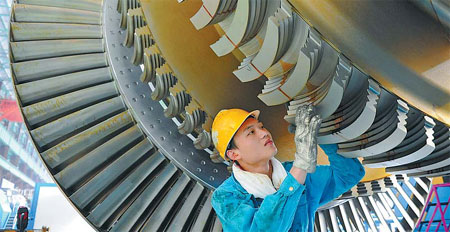Structural shift gaining momentum: AmCham
|
A worker in Deyang, Sichuan province, inspects a rotor, a key component of a nuclear power generator, that was independently developed by Dongfang Electric Corp. Chinese industries are trying to move up the value chain. Kou Yuanlin / for China Daily |
Structural changes in China's economy are already apparent and will accelerate, driven by external and internal factors, the American Chamber of Commerce said on Wednesday.
The strong commitment of US companies to the Chinese market is subject to China's future policy choices and development path, as well as external risks such as another global economic slowdown, the chamber said in its annual white paper on the State of American Business in China.
"The transition to a new economic growth model presents new challenges. A new commitment to deepen market reforms and extend a truly market economy to additional sectors of the economy will ensure more sustainable economic growth," said Ted Dean, AmCham China chairman.
Song Hong, a senior researcher at the department of international trade with the Chinese Academy of Social Sciences, said the white paper showed the chief concerns of US companies have shifted from the investment climate to the country's medium-term economic growth path.
China's course over the next decade as it seeks a structural shift has become a big concern for the foreign business community. They may think there are some ambiguities and uncertainties, but in fact China has given clear information, Song said.
The government is on track to make progress toward a market economy by actively promoting the liberalization of interest rates and further improving the exchange rate mechanism, as well as deepening the reform of State-owned enterprises, he said.
"China has no doubts about sticking to opening-up and gradually advancing its reforms in a cautiously optimistic way. A 'shock type' reform, expected by some people, is impossible in China," Song said.
Despite the uncertainties, companies remain relatively optimistic about China's market. Most of the surveyed companies expect to grow faster than China's real GDP this year, as they did in 2010 and 2011.
In the survey, 76 percent of the companies said they expect their revenue to grow in 2012, and 26 percent expect growth in the range of 11 to 20 percent, compared with the government's 7.5 percent target for GDP growth in 2012.
Most economists forecast real GDP growth this year will exceed 8 percent.
"The operating environment continues to be strong, especially when compared to the rest of the word," said the report.
However, rising costs have made nearly 90 percent of the surveyed companies believe that China is becoming a weaker competitor.
Management-level human resources are seen as the leading business challenge and non-management level constraints rank third, while other inputs such as the cost of land, rents, raw materials and transportation are also rising.
China is losing its competitiveness in labor costs and that will eventually lead to a structural change in manufacturing and trade, but it's also a positive outcome of ongoing efforts to rebalance the economy, said Song.
lanlan@chinadaily.com.cn



















